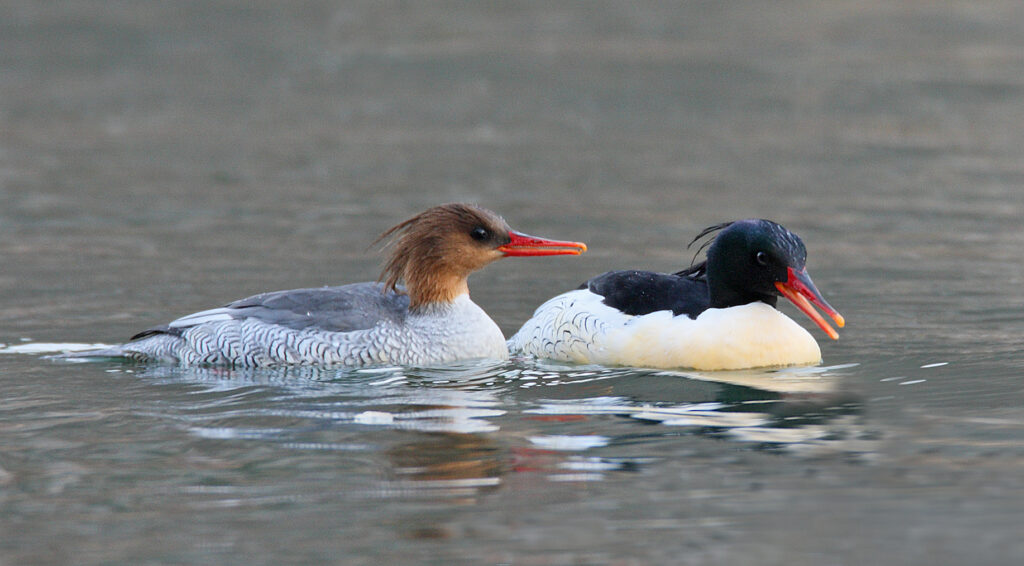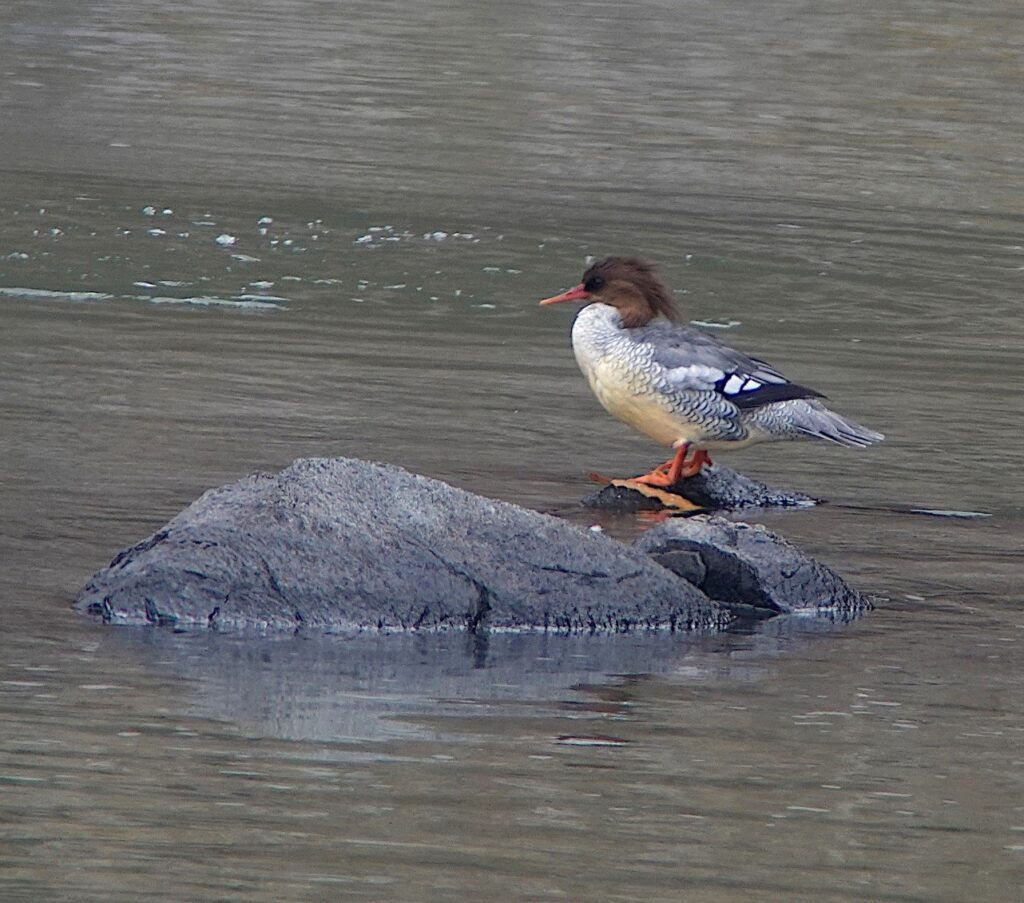(Introductory article written for the East Asian-Australasian Flyway Partnership as part of the 2022 Small Grant – written by Dr Nial Moores, Director, Birds Korea and IUCN SSC Threatened Waterfowl Specialist Group with translation of Korean version by Lee Su-Young, Yeoncheon Birds Korea, and Park Meena, National Coordinator Birds Korea)
Sitting low in the water, close to the river bank, a Scaly-sided Merganser rests, half-hidden by the shade of an overhanging tree and by a line of jagged black rocks. Waking, the bird moves away from us quietly, and is soon joined by another and then another. Seen well, the details of each of these birds is exquisite: jagged crests, bright fire-red bills, and flanks with black and white fish-scales that mirror perfectly the ripples and reflections on the water.

The Scaly-sided Merganser is a species that comes to Korea from the wildest river forests of East Asia, from summers in remote mountain valleys shared with the Siberian Tiger. They are shy, doing all they can to keep their distance from that most fearful of predators: people.
They need fish to survive, caught in a series of shallow dives, often close to the river bank or in riffles where the flow is fastest. Each autumn, as the rivers further north freeze-over they have no choice but to move south; to spend the winter in landscapes that must now seem almost unrecognizable to them – curving, gurgling rivers dammed and dredged and straightened; cars and camp sites on shingle banks; formerly dark, silent forested banks spotted with private houses and coffee shops and restaurants playing the latest K-Pop music; quiet river bends, once safe refuges, made ever-more accessible to fast-moving packs of cyclists and hikers on paved highways, apparently oblivious to the exceptional biodiversity around them. Fewer and fewer places remain in the Republic of Korea (ROK) for the Scaly-sided Merganser, and for many of the species that share the same habitat: ground-nesting Long-billed Plovers and tree-nesting Mandarin Ducks, River Otters and freshwater turtles and endemic fish species. A whole suite of species confined to ever-smaller spaces; once connected ecosystems now fragmented.
What can be done to slow down and then to reverse this decline in biodiversity, along Korean rivers and indeed in almost all the habitats on our increasingly degraded planet?
Birds Korea is an active member of the East Asian-Australasian Flyway Partnership (EAAFP) Scaly-sided Merganser Task Force. We are small, but like so many environmental NGOs around the world, we do all we can to support decision-makers with best science; and to accelerate progress toward sustainability by offering solutions clarified through tailor-made plans and designs. For the Scaly-sided Merganser, this means first finding where the species can still survive, and then identifying the most efficient ways to reduce disturbance, river stretch by river stretch. In a world where quick economic returns are valued over sustainability, this means identifying ways in which local communities can genuinely benefit from conservation, be it through eco-tourism, local branding or subsidy support, as well as in helping build local pride.
There is, as far as we know, still no fully protected stretch of river anywhere in the ROK which is 100% free from the threat of river-works and increasing disturbance. Nonetheless, 2022 has seen substantial progress.
Funded by Yeoncheon County, we have been able to build on research in the Yeoncheon Imjin River Biosphere Reserve – a core area for the species during migration – to identify key stretches, to propose mitigation measures, and to raise awareness. And thanks to a small grant from the EAAFP and funding from the Hanns Seidel Foundation office in Seoul, we were also able to conduct our third national winter survey of the Scaly-sided Merganser, finding 175 nationwide – about 4% of the estimated world population. We were also able to learn more about their migration strategy, counting 215 along three rivers in mid-November; and to hold the first workshop on the species, with wonderful activists sharing their insights. The EAAFP small grant also provided vital support for in-field training in identification and in counting, and in the production of an educational pamphlet
Much remains to be done, of course. But the information gaps are closing, and more and more people now feel their deep connection to this wary, fish-patterned bird, to this endangered spirit of the river wild.
For a link to the English-language version of the Small Grant report on the EAAFP website, please see here
Or alternatively, for the Executive Summary of the Small Grant Report and for an online version of the pdf please read on:
• The Scaly-sided Merganser Mergus squamatus is a globally Endangered, easily-disturbed species
of duck which is confined to East Asia and which is ecologically dependent on healthy, fish-rich,
and rather fast-flowing rivers for its survival;
• Birds Korea is an active member of the Scaly-sided Merganser Task Force within the East Asian-
Australasian Flyway Partnership (EAAFP);
• Tracking studies suggest that a potentially large number of Scaly-sided Merganser migrate across
the Korean Peninsula between breeding and wintering areas; and the species also over-winters in
the Republic of Korea (ROK). The ROK is therefore one of only four main range-states of the
species, with substantial responsibility for conservation of this species and its habitats;
• Proper assessments of numbers and of population trends in the ROK require more research;
• Research confirms that the national Winter Bird Census is insufficient for counting this species;
• National surveys conducted by Birds Korea in early 2012 and 2014 found 140-149 and 149
Scaly-sided Mergansers respectively (Moores & Kim 2014). Our national mid-winter survey in
2022 found 175;
• We are unaware of any research prior to 2021 focused on the migration phenology of the species
in the ROK;
• The EAAFP Small Grant of 4,000 USD in 2022 was used by Birds Korea to fund our own work
on the species, and to supplement related projects which were funded primarily by Yeoncheon
County and the Hanns Seidel Foundation (Korea office);
• During 2022, activities for the Scaly-sided Merganser conducted by Birds Korea and supported
directly or indirectly, in part or in whole, by this small grant included: additional counts of the
species along the Imjin River in Yeoncheon County, to build research capacity and to improve
understanding of migration phenology; reports submitted to Yeoncheon County identifying
threats to the species and potential mitigation responses; meetings with Yeoncheon County in
preparation for possible designation of the Imjin River as a Flyway Network Site focused on the
species; a national winter survey in February covering 16 rivers; additional counts along the
Namhan and selected stretches of the Nam and Umcheon Rivers to help with assessing migration
strategy; co-ordination with HSF of a small workshop on the Scaly-sided Merganser in
November, participated in by local activists working for the conservation of several rivers used
by the species (Imjin, Seomjin, Nam, Umcheon and Mangyeung); production of an awareness-
raising pamphlet on the species for distribution in 2023; preparation of this report; and
preparation for a collaborative scientific paper to be written in 2023.
• Observations made in 2022 extend the dates of presence in the ROK known to us, with the latest
record in spring along the Imjin River on April 12th; and the earliest returning individual in
autumn on October 8th on the Nam and Umcheon Rivers;
• Survey of three rivers alone in November 2022 recorded 215 Scaly-sided Merganser. This count
is higher than any previous national count of the species, and suggests that the species likely
peaks in abundance in the ROK in November, when staging and over-wintering birds overlap in
timing;
• The evidence to date suggests that the majority of wintering Scaly-sided Merganser have arrived
at key rivers by mid-November, remaining within these river-systems until March or early April,
with local distribution influenced strongly by construction activities and extent of freezing;
• Rivers which typically freeze over each winter do not support large numbers of Scaly-sided
Merganser in the mid-winter period. However, like the Imjin River, such rivers might still be
important or internationally important for the species during the main migration periods.
Executive Summary from: Moores, N. 2022. Small Grant Summary Report on the Project, “Improving the
Conservation Status of the Scaly-sided Merganser in the Republic of
Korea” (2022)
Pdf of full report
Final-report-for_EAAFP-small-grant-2022_for-blog

